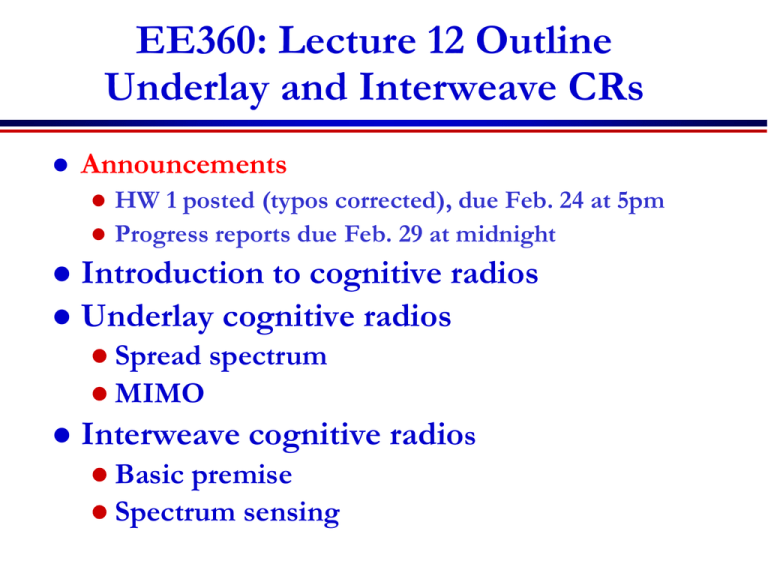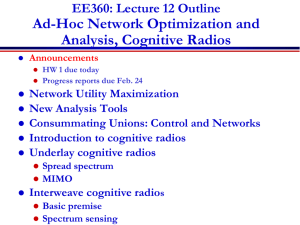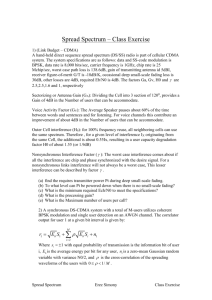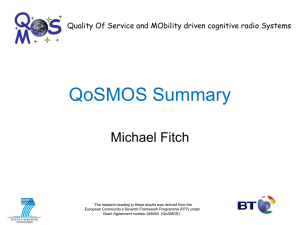Resource Allocation in Wireless Networks
advertisement

EE360: Lecture 12 Outline
Underlay and Interweave CRs
Announcements
HW 1 posted (typos corrected), due Feb. 24 at 5pm
Progress reports due Feb. 29 at midnight
Introduction to cognitive radios
Underlay cognitive radios
Spread
spectrum
MIMO
Interweave cognitive radios
Basic
premise
Spectrum sensing
CR Motivation
Scarce Wireless Spectrum
$$$
and Expensive
Cognition Radio Introduction
Cognitive radios can support new wireless users in
existing crowded spectrum
Utilize advanced communication and signal
processing techniques
Without degrading performance of existing users
Coupled with novel spectrum allocation policies
Technology could
Revolutionize the way spectrum is allocated worldwide
Provide sufficient bandwidth to support higher quality
and higher data rate products and services
What is a Cognitive Radio?
Cognitive radios (CRs) intelligently exploit
available side information about the
(a) Channel conditions
(b) Activity
(c) Codebooks
(d) Messages
of other nodes with which they share the spectrum
Cognitive Radio Paradigms
Underlay
Cognitive
radios constrained to cause minimal
interference to noncognitive radios
Interweave
Cognitive
radios find and exploit spectral holes
to avoid interfering with noncognitive radios
Overlay
Cognitive
radios overhear and enhance
noncognitive radio transmissions
Knowledge
and
Complexity
Underlay Systems
Cognitive radios determine the interference their
transmission causes to noncognitive nodes
Transmit if interference below a given threshold
IP
NCR
NCR
CR
CR
The interference constraint may be met
Via wideband signalling to maintain interference
below the noise floor (spread spectrum or UWB)
Via multiple antennas and beamforming
Underlay Challenges
Measurement challenges
Measuring
Measuring
interference at primary receiver
direction of primary node for
beamsteering
Policy challenges
Underlays typically coexist with licensed users
Licensed users paid $$$ for their spectrum
Licensed users don’t want underlays
Insist on very stringent interference constraints
Severely limits underlay capabilities and applications
Ultrawideband Radio (UWB)
Uses 7.5 Ghz of “free spectrum” (underlay)
UWB is an impulse radio: sends pulses of tens of
picoseconds(10-12) to nanoseconds (10-9)
Duty cycle of only a fraction of a percent
A carrier is not necessarily needed
Uses a lot of bandwidth (GHz)
High data rates, up to 500 Mbps, very low power
Multipath highly resolvable: good and bad
Failed to achieve commercial success
Null-Space Learning in MIMO CR Networks
Performance of CRs suffers from interference constraint
In MIMO systems, secondary users can utilize the null
space of the primary user’s channel without interfering
Challenge is for CR to learn and then transmit within the
null space of the H12 matrix
We develop blind null-space learning algorithms based on
simple energy measurements with fast convergence
Problem Statement
Consider a single primary user, User 1
Objective: Learn null space null(H1j), j1 with
minimal burden on the primary user
Propose two schemes:
Passive primary user scheme: Primay user oblivious
to secondary system
Active primary user scheme: Minimal cooperation
(no handshake or synchronization). Faster learning
time.
System Setup
Note: q(t) can be any monotonic function of y2(t)
Energy is easily measurable at secondary transmitter
Learning Process
The SU’s learns the null space of H12 by inserting a series of
input symbols {Wk1~x2 (n)} and measuring q(n)=fk().
The only information that can be extracted is whether q(n)
increases or decreases
Is this sufficient to learn the null space of H12?
Yes!
The problem is equivalent to a blind Jacobi EVD decomposition
The theorem ensures that Jacobi can be carried out by a blind 2D
optimization in which every local minimum is a global minimum.
Can Bound Search Accuracy
More relaxed constraints on PU interference leads to better
performance of the secondary user
This technique requires no cooperation with PU
If PU transmits its interference plus noise power, can speed
up convergence significantly
The proposed learning technique also provides a novel
spatial division multiple access mechanism
Performance
Summary of Underlay MIMO Systems
Null-space learning in MIMO systems can be
exploited for cognitive radios
Blind Jacobi techniques provide fast
convergence with very limited information
These ideas may also be applied to white space
radios
Interweave Systems:
Avoid interference
Measurements indicate that even crowded spectrum
is not used across all time, space, and frequencies
Original motivation for “cognitive” radios (Mitola’00)
These holes can be used for communication
Interweave CRs periodically monitor spectrum for holes
Hole location must be agreed upon between TX and RX
Hole is then used for opportunistic communication with
minimal interference to noncognitive users
Interweave Challenges
Spectral hole locations change dynamically
Detecting and avoiding active users is challenging
Need wideband agile receivers with fast sensing
Compresses sensing can play a role here
Spectrum must be sensed periodically
TX and RX must coordinate to find common holes
Hard to guarantee bandwidth
Fading and shadowing cause false hole detection
Random interference can lead to false active user detection
Policy challenges
Licensed users hate interweave even more than underlay
Interweave advocates must outmaneuver incumbents
White Space Detection
White space detection can be done by a single
sensor or multiple sensors
With multiple sensors, detection can be
distributed or done by a central fusion center
Known techniques for centralized or distributed
detection can be applied
Detection Errors
Missed detection of primary user
activity causes interference to
primary users.
False detection of primary user
activity (false alarm) misses
spectrum opportunities
There is typically a tradeoff
between these two (conservative
vs. aggressive)
Summary
Wireless spectrum is scarce
Interference constraints have hindered the
performance of underlay systems
Exploiting the spatial dimension opens new opportunities
Interweave CRs find and exploit free spectrum:
Primary users concerned about interference
Much room for innovation
Philosophical changes in system design and
spectral allocation policy also required
Presentation
“A Survey of Spectrum Sensing Algorithms
for Cognitive Radio Applications”
Authors: T, Yucek and H. Arslan
Presented by Ceyhun Akcay







